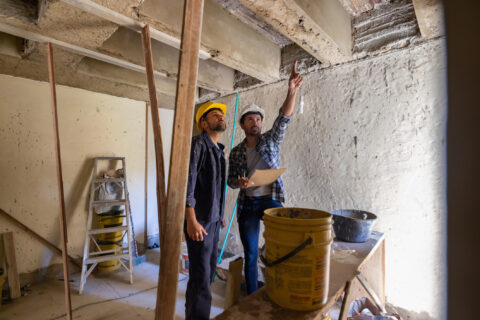The City of Arcata is a coastal community of about 18,000 located in rural Northern California. Surrounded by redwood forests, at the edge of Humboldt Bay, and bordered by the Mad River this picturesque college town is vulnerable to numerous natural disasters such as earthquakes, tsunamis, landslides, and wildfires. In the fall of 2019, the City was affected by the Public Safety Power Shutoff (PSPS) events, and (along with many other cities and regions of California) spent days in two separate power outages due to high wind and wildfire risks. As the number and intensity of hazards increase with the effects of climate change, staff recognized the need to increase City preparation for potential disasters.

Over the course of 2020, the City of Arcata updated its Emergency Operations Plan (EOP) and created functional hazard annexes for specific disaster scenarios including earthquake/tsunami, wildfire, and—most recently—communicable disease outbreak. As all local government staff are Disaster Service Workers (and thus able to be called on in the event of an emergency), educating the City’s departments about their roles and responsibilities in various emergencies is crucial to protect the health and welfare of Arcata’s residents and ensure the continuity of critical operations.
Through the PSPS events, the City also became aware of the need to communicate with Limited English Proficiency (LEP) Spanish-speaking residents regarding risks, ways to prepare, and how to stay informed. Through Arcata’s resilience project, the City hired its first Translator/Interpreter, Laura Muñoz, to translate preset Spanish messages for its emergency alert notification system (CodeRED), as well as the resources available on its Emergency Preparedness webpage.
NLC’s Nick Kasza held a virtual discussion with Arcata’s Gillen Martin, Tracy Watkins, and Laura Muñoz about their experience in the Leadership in Community Resilience program and the progress the city made during the last year. Some of the responses have been edited for clarity.
Nick Kasza: Arcata sounds like a very charming city with a wealth of outdoor activities and nature to explore. Living and working in Arcata, do you ever stop and think about the various risks the community faces?
Gillen Martin: Personally, I don’t think about the natural disasters we are vulnerable to here in Arcata in my day-to-day. Not until something brings me face to face with them. For example, I was getting out of town with a friend this winter, and while driving on Highway 101 we were turned around by a landslide about an hour north from Arcata. As we turned around and started driving back, we talked about how wild it is that if only two other highways had landslides simultaneously (which is entirely possible with a Cascadia subduction zone earthquake event) Humboldt County could be entirely cut off from road access.
Nick: And that could mean fuel, food, and other supply shortages as well as reducing the ability of outside help to arrive which means there’s definitely a need to improve local resilience practices. What motivated the City to apply to the Leadership in Community Resilience program?
Gillen: Following the PSPS events in the fall of 2019, Nancy Garcia—a student journalist at our local Humboldt State University (HSU)—wrote a piece in El Leñador, a duel Spanish/English publication on campus. She pointed out that Humboldt County, as well as the City of Arcata and our neighboring jurisdictions, were sending out emergency alerts solely in English to a community that includes a substantial Limited English Proficiency (LEP) population. Furthermore, many of Arcata’s LEP/primarily Spanish-speaking residents live in our lowest-lying neighborhood, right along the Mad River and in the tsunami inundation zone, making this hard-to-reach population most vulnerable to the potential impacts of flooding, tsunamis, or failure of the Matthew’s Dam (which is upriver of Arcata).
Tracy Watkins: As a small city in a rural area, our roughly 160 person staff have little capacity and resources with which to engage in the emergency preparedness training we need in order to fulfill our duties as Disaster Service Workers. We are using half of the funding from the LCR program for staff training.
Nick: Tell me about the translation work that was done on the website and for the emergency notification system. What was translated? Why is it important that this work happened?
Laura Muñoz: With LCR funds, the city hired me to help with this project on a temporary basis. I translated preset messages for different emergencies—from a water main break to “tsunami coming!” Additionally, I translated all of the household preparedness materials on the emergency prep webpage, local COVID-19 information, and several other documents related to public safety and community policing in Arcata. Especially during the period of civil unrest that we have seen over this year, it is crucial that our local and national dialogues are available and open to participation by the majority of the community.
Gillen: We also added a Google Translate feature to our City website that allows for the information on every page to be translated into any language, though we still have to translate the PDFs and other linked materials.
The documents we translated through LCR grant funds were chosen because they are crucial for our residents’ preparedness—it is a life safety issue. Although Laura’s position was initially funded by this grant, she is staying on after the funds have been utilized because the City wants to ensure its communications are accessible to as many residents as possible. The City of Arcata is sending out press releases, social media information, and even providing interpreted summaries of meetings in Spanish. This program provided us with startup funds required to systematize a position that has been needed. As a City, our communications, especially emergency alerts and others to do with life safety, need to be accessible to all of our residents. We know there is a Spanish-speaking/LEP population in Arcata; consequently, if our communications are only going out in English—then they are not accessible to all.
Nick: How are you engaging with residents to make sure they know about the translated resources and encouraging them to sign up for CodeRED?
Laura: Gillen and I have been interviewed for local news media, attended a District English Learners Advisory Council (DELAC) meeting, and partnered with Centro del Pueblo (a local community organization uniting and serving Arcata’s Latinx Spanish-speaking populations) to spread the word. Nancy Garcia, the journalist that wrote the original piece in the bilingual Humboldt State University paper, EL Leñador, has also published the information.
Tracy: We also used some of the LCR funds to create a banner that hangs in the Arcata Plaza, our town square, pointing people to our Emergency Preparedness and CodeRED sign-up webpages in both Spanish and English.
Gillen: Our Communications Specialist Cati Gallardo here at the City has also been crucial in helping us make our efforts known throughout this program. Information regarding CodeRED and emergency prep has been included in press releases, social media postings, and local COVID-19 information sent out in Spanish and English.
Nick: And how’s the response been? Have you seen an increase in sign-ups for CodeRED and webpage visits?
Gillen: Yes! During the PSPS events, we had under 10,000 CodeRED subscribers. Now—a little over a year later—we have 11,634. Between 2019 and 2020, we also saw a 47% increase in visits to our Emergency Preparedness webpage and a 13% increase to our CodeRED webpage.
Nick: That’s great, glad to see the city’s efforts making a difference. During 2020 there was also a lot of effort spent updating the Emergency Operations Plan and creating new hazard annexes. Can you describe those efforts and what the goal was?
Tracy: While updating our Emergency Operations Plan (EOP), we made sure that our staff’s emergency organization is streamlined and comprehensible both internally and externally. Our plan also has resources, such as Emergency Operations Center (EOC) position check-lists, that will help our staff if they are called in to perform Disaster Service Worker duties. The hazard annexes help us understand our individual role, the roles of other departments (as well as partnering agencies), and how we all interact within the context of disasters.
Gillen: Updating these plans allowed the City to build and strengthen relationships with crucial partners in emergencies, such as our National Weather Service (NWS) office, County of Humboldt emergency preparedness program staff, the Arcata Fire District, Arcata’s Community Emergency Response Team (CERT), and our university’s emergency management team.
Nick: It sounds like the city made a real effort to create an inclusive and equitable culture of preparedness. What are your key takeaways from this project and how would you like to see Arcata continue to elevate resilience and emergency preparedness in the future?
Tracy: We have made a lot of progress towards being more disaster prepared. But we have a lot more work to do, both as a City and as a community, to be prepared for disasters.
Gillen: I agree with Tracy. Our work over the LCR program year represents some big steps. However, it seemed that with everything we completed, we found even more plans to be written or trainings to engage our staff in—preparedness opportunities that could really make a difference in the Arcata community. A sort of “tip of the iceberg” situation.
Laura: It takes a community, not just a small group of people or planners. Preparedness is not top-down—it is horizontal, and it takes everybody. Right now, Spanish is the main second language. But it is important to have systems that include other communities: our Native communities, those communities that speak languages besides Spanish or English, the Hmong population here in Humboldt County. Arcata continues to change, and we should be prepared not only for disasters but also for future demographic shifts so that we can continue to serve our entire community.
Gillen: Another key takeaway for me was certainly comprehending the important role of cultural and community organizations in preparedness. We have an incredibly strong network of nonprofits and community groups here in Arcata, and partnering with them to spread the word regarding disaster preparedness and Spanish translations has been invaluable. In emergency situations, people will not only look to their City or County, but also their established networks for support. Thankfully, we have these incredible nongovernmental support structures that already strengthen and build community in our city.
Nick: Have any next steps been identified to keep the momentum going?
Tracy: Our City staff just finished our Incident Command System trainings and met to discuss how they relate to our recently completed plans. Staff are now moving to Community Emergency Response Team (CERT) online training modules and will complete the in-person portions of CERT training later this summer. Following this, we hope to hold a tabletop exercise to review our recently completed hazard annexes and hopefully establish a regular schedule for the exercises.
Gillen: The final portion of our LCR funds will go to a second CERT training in early 2022 that will be open to the community rather than our staff—in order to help Arcata CERT recruit new team members. Through the process of updating our emergency plans, our current CERT members were also officially sworn in as Disaster Service Worker Volunteers (DSWVs) which allows them to operate in mutual aid situations outside of Arcata city limits.
Laura: And, as was mentioned earlier, our translations work has already extended beyond this program, on a weekly basis the City of Arcata is now providing information and communication in Spanish.
You can visit Arcata’s Emergency Preparedness webpage here and their CodeRED webpage here.
The Leadership in Community Resilience (LCR) grant program supports and enhances local capacity among elected leaders and staff, communities, and community-based organizations as they pursue coordinated climate resilience efforts. Since 2017, 33 cities have participated in the LCR program.








